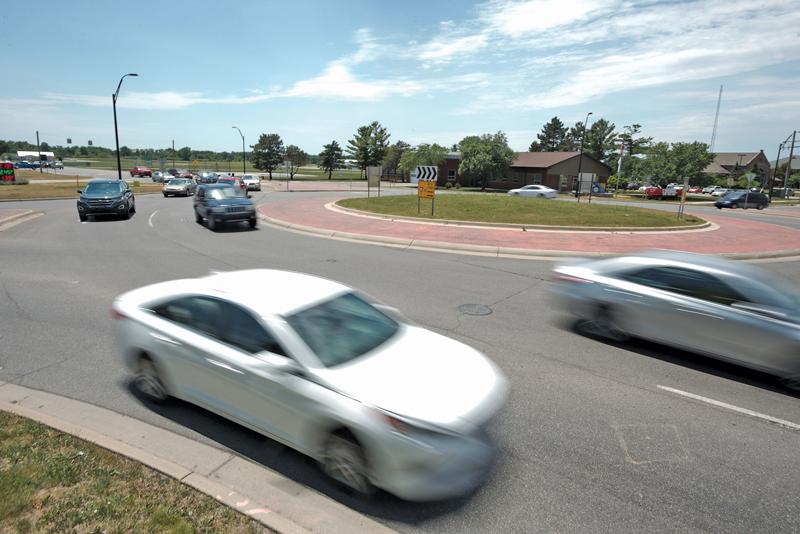The director of the Washtenaw County Road Commission is speaking of the two-lane roundabout his department built in 2013 at the often congested intersection of State and Ellsworth. Though the commission doesn’t have the stats to show that traffic flows better now, local authorities agree with Townsend’s assessment—more or less.
“It’s better than it was,” says Mandy Grewal, supervisor of Pittsfield Township, whose police have jurisdiction over the intersection. “It moves better than it did when we had traffic lights for sure. But it could be better.”
“It’s improving,” agrees Pittsfield police chief Matt Harshberger. “We believe traffic is getting through faster. At rush hour it slows down a little bit. Folks are getting used to it more now.
“But we’ve seen an increase in crashes,” the chief adds. “Most of the time, it’s failure to yield. Folks are not able to gauge the gap necessary to enter.”
Roundabouts are claimed to improve safety as well as improving traffic flow. That seems to be true at single-lane roundabouts, but this one has two lanes—and the number of crashes soared after the change. Pittsfield police statistics show an average of fourteen crashes in the three years before the roundabout was built. That jumped to 170 crashes in 2014. Though the rate fell to 114 in 2015, then to 106 last year, that’s still more than seven times the rate at the old stoplight.
In a July blog post, Michigan Auto Law attorney Steven Gursten ranked the intersection as the most dangerous in greater Ann Arbor. He counted every accident within 250 feet of an intersection, including freeway on- and off-ramps, which may explain why he came up with a slightly higher total of 120 accidents at State and Ellsworth last year—that was nearly double the sixty-five he counted at the next worst intersection, Hogback and Washtenaw. But Gursten also noted that just five State-Ellsworth accidents caused injuries; Hogback-Washtenaw had eleven. That’s because roundabout crashes are less severe, mostly sideswipes compared with the more serious T-bone common at intersections.
To help drivers navigate, “overhead signs were installed in November 2016,” emails road commission communications coordinator Katie Parrish. “They are the same type of arrows that you would see at a traditional intersection. They indicate which lane to select as you approach the State and Ellsworth roundabout.”
The road commission doesn’t know if the signs have worked. “We want to evaluate data at the one-year mark,” Parrish emails. They aren’t planning any other physical changes to the roundabout: “We are focusing on driver education.”
That’s Pittsfield’s strategy, too. “It’s a matter of continuing to do education and some more enforcement details,” says Harshberger. “In the month of April we did multi-jurisdictional enforcement details focused on education—[especially] distracted driving—the Michigan State Police, the Washtenaw County Sheriff’s Office, the Ann Arbor Police Department, and the Pittsfield Police.
“We made 322 stops at all the roundabouts around the county,” the chief continues. “We wrote seventy-seven tickets and made four arrests: one felony and a couple misdemeanors. Mostly, we gave out 241 warnings and handed out pamphlets about the rules of roundabouts.
“I expected just a few tickets. It’s not about handing out tickets. It’s about changing drivers’ behavior.”
He says a lot of behaviors need changing. In a follow-up email, Harshberger starts with “putting phones down,” then adds a long list of other distractions, including fiddling with the radio, “drinking/eating,” and “talking with passengers … Your full attention is needed to ensure your safety, as well as that of other motorists and pedestrians who may also be trying to use the crosswalks.”
It’s not that drivers are more distracted in roundabouts—it’s that multilane ones demand extra vigilance. Drivers have to choose the correct lane before they enter, then turn sharply while maneuvering only a few feet away from other vehicles. In Brighton, a three-lane roundabout at Lee and Whitmore Lake roads has caused so much confusion that the Livingston County Road Commission is considering taking out a lane.
Drivers do much better with single-lane roundabouts, like the one under construction at Scio Church and Wagner roads. With the current four-way stop, “It takes as long as 20 minutes to travel through the intersection during peak hours,” writes Parrish. Once the roundabout is completed, she predicts, the “delay on average will be less than 30 seconds.”
